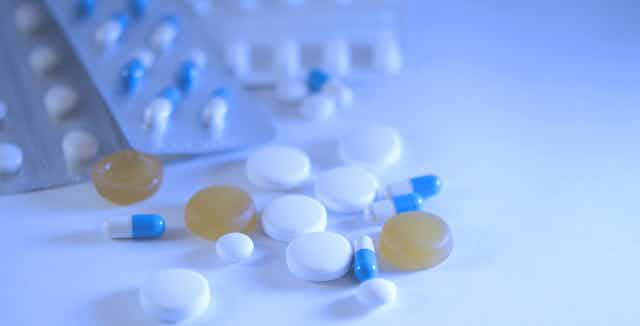This week, the government announced the latest additions, amendments, and deletions from the Pharmaceutical Benefits Scheme (PBS): the program through which essential medicines are subsidised for Australian patients. The new medicines on the scheme are reportedly worth A$310 million.
Listing on the PBS is different to a drug being approved for sale by Australia’s drug regulator, the Therapeutic Goods Administration (TGA). Once approved by the TGA, it is available to patients and hospitals at the full price. It only becomes subsidised if later listed on the PBS.
Some of the notable additions to the list include drugs to treat eye infections, human immunodeficiency virus (HIV), cystic fibrosis, multiple sclerosis, cancer, and idiopathic pulmonary fibrosis – a type of scarring in the lungs. Below is a list of seven most notable new additions to the scheme.
1. Chloramphenicol eye drops (Chlorsig)
-
Maximum cost to Aboriginal and Torres Strait Islanders: A$0-6.10
Maximum cost to other patients: A$20.11
Chloramphenicol is the generic name of an antibiotic drug used to treat eye infections. It has been added to the PBS with the restriction that it is only available to patients who identify as Aboriginal or Torres Strait Islander (ATSI).
The rate of eye infections, like trachoma (which leads to blindness), is three times higher for ATSI patients than for other Australians. The lower price for ATSI patients is because of extra funding under the government’s Closing the Gap PBS co-payment program.
2. Ivacaftor (Kalydeco)
Maximum price from the manufacturer: A$22,547.02
Maximum cost to the patient: A$38.80
Ivacaftor – first approved by the TGA in September 2016 – is used to treat cystic fibrosis, a genetic disorder that affects the digestive system and lungs of patients. It causes a buildup of thick and sticky mucus in the airways.
There is no cure for cystis fibrosis, but ivacaftor acts by better regulating the flow of salts and water in and out of cells, which leads to less mucus buildup.
While around 3,300 people in Australia live with cystic fibrosis, only around 10% of patients will benefit from the drug. This is because patients need to have a specific mutation in their DNA called R117H for the drug to be effective.
More information - Weekly Dose: Kalydeco, the drug that treats the cause of cystic fibrosis, not just symptoms
3. Blinatumomab (Blincyto)
Maximum price from the manufacturer: A$61,975.54
Maximum cost to the patient: A$38.80
Blinatumomab is a new type of immunotherapy – a treatment that empowers the body’s immune system to fight diseases such as cancer.
The drug is approved for use to treat a specific subset of acute lymphoblastic leukaemias (ALL). Around 350 Australians each year are diagnosed with some form of ALL, and it is the most common type of cancer in children.
Blinatumomab was first approved by the TGA in November 2015 but an application to list the medicine on the PBS that same year was rejected. It has been reported that the cost for patients before the PBS subsidy was A$127,700 per course of treatment.
4. Fosaprepitant (Emend IV)
Maximum price from the manufacturer: A$115.03
Maximum cost to the patient: A$38.80
This drug is used to help patients overcome the nausea and vomiting side-effects associated with chemotherapy treatment. Fosaprepitant has been available for doctors to prescribe since 2011, when it was first recommended to be put on the PBS.
5. Emtricitabine
Maximum price from the manufacturer: A$1,500 - $2,600 depending on the formulation
Maximum cost to the patient: A$38.80
Four formulations of this drug have been added to the PBS as part of a cocktail of medicines used to treat HIV infection.
Emtricitabine acts by stopping the HIV virus from copying itself into human cells. It was first approved by the TGA in 2005 and other formulations of the drug – such as it being coupled with antiviral Tenofovir under the brand name Truvada – have been listed on the PBS previously. In Australia, there are around 25,000 people living with HIV.
More information: Weekly Dose: Truvada, the drug that can prevent HIV infection
6. Daclizumab (Zinbryta)
Maximum price from the manufacturer: A$2,231
Maximum cost to the patient: A$38.80
Daclizumab is used to treat multiple sclerosis (MS), a condition that affects the nervous system and interferes with nerve impulses in the brain, spinal chord, and optic nerves (those responsible for vision). It was first approved by the TGA in September 2016.
While there is no cure for MS, this drug helps to stop infection-fighting blood cells called T-cells from getting into the brain. This protects the brain from swelling. There are currently around 24,000 Australians who live with MS.
7. Nintedanib (Ofev)
Maximum price from the manufacturer: A$3,385.48
Maximum cost to the patient: A$38.80
Nintedanib was approved by the TGA in September 2015. It is used to treat idiopathic pulmonary fibrosis, a condition that causes scarring in the lungs. The amount of scar disease builds up over time. While nintedanib does not cure patients, it provides relief by stopping the enzymes that help create the scarring, thus slowing the disease.
The condition is most prevalent in people over 60 years of age, and affects around 2,600 Australians.

